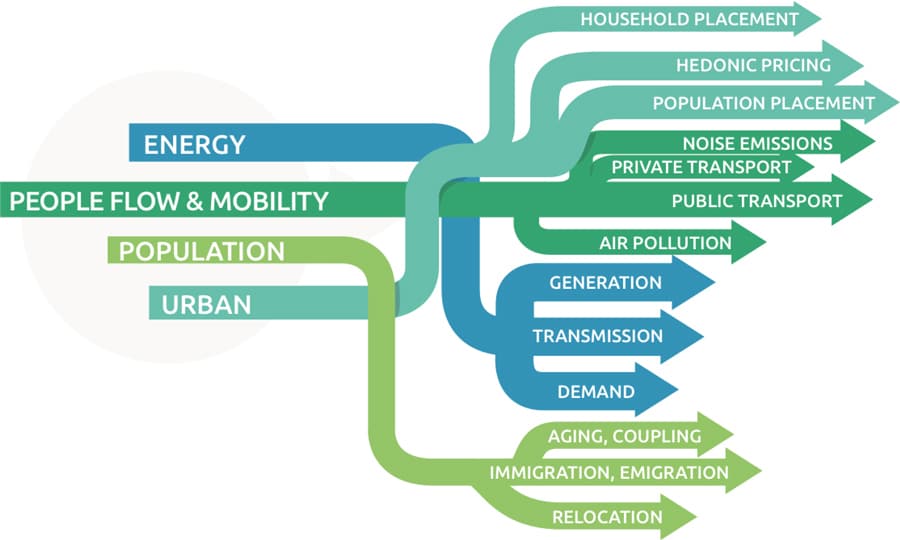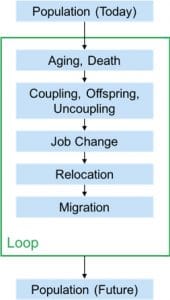Agent-based modelling of immigration impact
In Switzerland, 80% of the annual population growth is a result of immigration. Consequently, foreign nationals make up 25% of Switzerland’s resident population. Migration often has the effect of slowing down the ageing of the population, which could be beneficial in a country where, in the last century, the proportion of residents over the age of 65 has risen from 5.8% to 17.8%, and the proportion of those over 80 has increased from 0.5% to 5.0%. Moreover, there are concerns that the Swiss social security system is at risk if there is insufficient growth in the labour force to cover the cost of supporting social security insurances, such as pension funds and occupational benefit plans, for an ageing population.
The European Commission deems the issue of demographic ageing as important as global warming. Designing policies that meet the needs of an entire society, however, is a daunting task and policy makers depend on immigration policies and quotas, derived from models of immigration impact, as vehicles to control demographics.
Classical modelling methods based on past trends rarely account for future changes in population and economy, or changes resulting from more complex issues. Artificial intelligence approaches permit the simulation of complex systems but require the collection and standardisation of huge amounts of data so generating results within a reasonable timeframe is challenging and often results are compromised by reducing complexity, the number of time intervals and/or the spatial extent of the simulation.

Marcello Marini, a PhD student with the Laboratory for Energy Conversion (LEC) Group, at the Institute of Energy Technology, ETH Zürich, together with Dr Ndaona Chokani, also with the LEC Group, ETH Zürich, and Professor Reza S. Abhari, Director of the LEC, ETH Zürich, has developed an artificial intelligence model that significantly reduces simulation times allowing for higher complexity and the extension to full-country scale.
A new agent-based model
Agent-based modelling, where population agents represent members of the population, simulates interactions between agents as well as interactions between agents and their environment. The research team have created an agent-based simulation framework, with an extensive database, detailing population, buildings, mobility infrastructure and energy infrastructure, covering the geographic extent of Europe. They also employ Graphical Processing Unit (GPU) computer architecture, which allows them to reduce simulation times without reducing complexity or scale.
The outcomes from the agent-based simulations demonstrate how managing immigration could address the long-term sustainability of the Swiss social security system.
The researchers have extended the agent-based simulation framework, EnerPol, developed in-house at the LEC, with a dynamic agent-based population model that dynamically simulates the individual life cycle and choices of agents, together with the formation and transformation of their household, taking economic, geographic, and urban factors into account.

Submodels
The agent-based population model is made up of a number of submodels which simulate the annual evolution of the population up to a target year. The ageing and deathing submodel increases an agent’s age with each simulated year. Agents’ deaths occur with a probability based on their age and gender. The coupling, offspring, and uncoupling submodel also depend on probabilities. The probability of coupling is a function of marital status, age, and employment status. The probability of offspring for each household depends on the age of the woman and the current number of children. The chance of uncoupling for households is computed for a proportion of couples. The job change submodel triggers a change in job depending on the agent’s satisfaction, income and house-to-work distance. The relocation submodel initiates relocation for households depending on their satisfaction in terms of the size and cost of the dwelling and house-to-work distance. Migrating agents are exogenously specified in the migration submodel which determines the number and size of immigrating and emigrating households each year. New agents are added to the simulation and assigned jobs and dwellings depending on their households’ characteristics. Throughout these submodels, a GPU-accelerated choice model provides for fast computations of the available choices for agents.
Countrywide population simulation
The research team chose to use the population of Switzerland as a test case so that they could examine the impact of possible future migration patterns on an actual population. A digital country twin was created, enabling them to determine the impact of migration on the social security cash flows and identify policy measures impacting immigration, thus influencing social security solvency.
Three scenarios
The researchers set up three scenarios: the ‘business as usual’ scenario is based on a projection of the historical trends of migrations as reported by the Swiss Federal Office for Statistics; the ‘large families’ scenario involves a transformation in the structure of immigrants’ households that assumes a move towards larger families with children; and the ‘demographic stagnation’ scenario, considers a possible reaction to the increase in migration, by limiting the number of immigrants to 50% of those in the business as usual scenario, keeping the net migration quota at 40,000 – 50,000 individuals per year.

The inputs of initial population distributions and the parameters influencing mortality, coupling, decoupling, and natality rates were based on historical data and were the same for the three scenarios. The transportation infrastructure remained unchanged throughout the simulation period which ran from 2014 to 2035 for all three scenarios.
The model outcomes have highlighted the impact of immigration on both the demands for suitable housing and urban development.
The research team examined the impacts of the three different immigration scenarios on the Swiss social security system’s solvency. They discovered that if annual immigration rates were to be limited to 50% of today’s rate, Switzerland’s social security system would be insolvent by 2027. If immigration rates are tailored to favour large immigrant families with children, however, the researchers found that the social security system would be more sustainable.

The outcomes from the agent-based simulations demonstrate how managing immigration could address the long-term sustainability of the Swiss social security system. These simulations show how the birth rate could increase with immigrant populations, thus mitigating the effect of the current ageing population. The total population, however, would be greater than if immigration was restricted so there would be an increase in the demand for housing and services.
Immigration and future housing needs
To explore the impact of demographic changes on the urban environment, the researchers carried out further simulations in the Swiss agglomeration of Lausanne. They employed extended versions of the same models and scenarios in order to achieve a more detailed analysis of housing requirements in Lausanne over the same period from 2014 to 2035.
The agent-based modelling revealed that the city’s building capacity would reach a limit in 2022. As a consequence, the population increased in the periphery of the agglomeration of Lausanne with the construction of new smaller apartments suited to the smaller households that tend to move to the periphery. The availability of schools and services in the city centre means that families tend to move towards the centre of the city, and over time, the simulations show an increase in the numbers of family households when compared with numbers of singles and couples households.

These simulations demonstrate a requirement for more services in the periphery of Lausanne to be aimed at the increasing demographic of smaller households. Furthermore, the majority of workplaces would still be situated in the city centre, so when planning improvements to the transportation infrastructure, the initial focus should be on improved access to the periphery.
Research outcomes
The research team have shown how their artificial intelligence agent-based model can carry out multi-resolution spatial analysis ranging from a single dwelling to an entire country. They can quantify the impact of immigration on demographics and urban infrastructures. The model outcomes have highlighted the impact of immigration on both the demands for suitable housing and urban development as well as the long-term sustainability of the country’s social security system. Moreover, they have demonstrated how agent-based models can support the design of policies that address the relative prosperity and social security needs of the whole society.
Personal Response
What advice would you give to policy makers regarding immigration policies and quotas?
Policy makers should not focus on ‘simplistic’ solutions to the immigration question, such as specific quotas, but rather focus on typologies of immigrant households which may address the broader context. As an example, we have demonstrated that on one hand more family-friendly immigration policies increase the natural growth of the existing population. On the other hand, family-friendly policies attract migrants composed of young families who must be integrated in the long-term, as opposed to single-household workers whose primary goals include a return to their home countries. As a consequence, family-friendly immigration policies yield an investment in the future that makes the support of workforce and social security more sustainable.